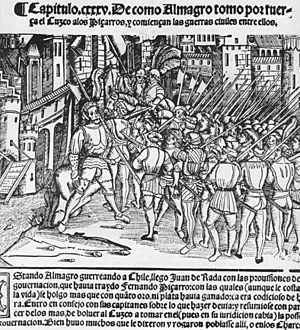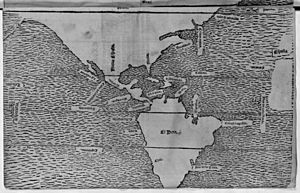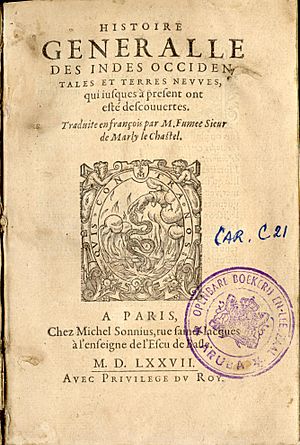Historia general de las Indias facts for kids
Historia general de las Indias (which means General History of the Indies) is a famous book by the Spanish historian Francisco López de Gómara. It tells the story of the Spanish conquest of the Aztec Empire. The book was first printed in December 1552 in a city called Zaragoza, Spain. Its first title was La istoria de las Indias (The History of the Indies).
Over the years, the book was updated and published with different names. The Spanish Crown actually banned it in 1556. But even with the ban, it was still published in other languages until 1605. For almost 150 years, you couldn't find new copies of it. Today, most modern versions of the book focus on the part that talks about the conquest of the Aztec Empire.
Contents
Different Book Versions
In 1553, the book was printed again by the same company, keeping its original name. Another version came out that same year with a longer title: Hispania Victrix, primera y segunda parte de la Historia General de las Indias con todo el descubrimiento y cosas notables que han acaecido dende que se ganaron hasta el año de 1551. Con la conquista de México de la Nueva España. This translates to Hispania Victrix, First and Second Parts of the General History of the Indies, with the Discovery and Notable Events that have Occurred Since it was Won until the Year 1551. With the Conquest of Mexico of New Spain.
This edition included a special letter to Emperor Charles V, who was King of Spain and ruler of the Indies. In this letter, Gómara wrote:
"Muy soberano señor: La mayor cosa después de la creación del mundo, sacando la encarnación y muerte del que lo crio, es el descubrimiento de Indias; y así, las llaman Mundo Nuevo. Y no tanto le dicen nuevo por ser nuevamente hallado, cuanto por ser grandísimo, y casi tan grande como el viejo, que contiene a Europa, África y Asia. También se puede llamar nuevo por ser todas sus cosas diferentísimas de las del nuestro. Los animales en general, aunque son pocos en especie, son de otra manera; los peces del agua, las aves del aires, los árboles, frutas, yerbas, y grano de la tierra que no es pequeña...."
This means: "Very powerful lord: The greatest thing after the creation of the world, besides the creation and death of its creator, is the discovery of the Indies. That's why they are called the New World. They are called new not just because they were newly found, but because they are huge, almost as big as the Old World (Europe, Africa, and Asia). It can also be called new because everything there is very different from our world. The animals, though few in types, are different. The fish, birds, trees, fruits, grasses, and grains are also unique."
In 1554, Gómara added more dates to the book. This new version was called "La historia General de las Indias y Nuevo Mundo, con más de la conquista del Perú y de México" (The General History of the Indies and the New World, with More on the Conquest of Peru and Mexico). It was published in Zaragoza.
The author also dedicated the second part of the book to "muy ilustre señor don Martín Cortés, marqués del Valle" (Very illustrious Don Martín Cortés, marquess of the Valley). Martín Cortés was the son of Hernán Cortés, the famous conqueror of Mexico. Gómara wrote:
"A ninguno debo intitular, muy ilustre Señor, la Conquista de México, sino a vuestra señoría, que es hijo del que lo conquistó, para que, así como heredó el mayorazgo, herede también la historia. En lo que uno consiste la riqueza, y en otro la fama; de manera que andarán junto honra y provecho..."
This means: "To no one should I dedicate the conquest of Mexico, illustrious sir, but to your lordship, who is the son of the one who conquered it. So, just as you inherited your family's wealth, you should also inherit this history. One brings riches, and the other brings fame, so honor and benefit will go together."
The book became very popular and was translated into Italian, French, and English. It was published in cities like Rome, Venice, Paris, and London. New editions were printed outside Spain between 1556 and 1605.
Where Gómara Got His Information
Gómara never actually traveled to America himself. Instead, he gathered information from news that reached Spain. He also used the limited maps of the newly conquered lands. His main sources included:
- Writings from a friar named Toribio de Benavente "Motolinia"
- Books by Gonzalo Fernández de Oviedo y Valdés
- Reports from explorers like Pedro de Alvarado and Andrés de Tapia
- Interviews he had with Hernán Cortés himself
What Other Historians Thought
Many historians who lived around the same time as Gómara had different opinions about his book.
- The Peruvian writer Inca Garcilaso de la Vega used Gómara's book as a source for his own work, Comentarios Reales de los Incas. We even have a copy of Gómara's book with notes written by Garcilaso de la Vega.
- Francisco Cervantes de Salazar copied a lot from Gómara's book for his Crónica de la Nueva España.
However, not everyone liked it.
- Bernal Díaz del Castillo, who was a soldier in the actual expeditions, strongly criticized Gómara's book in his own work, Historia verdadera de la conquista de la Nueva España. Díaz del Castillo was upset because Gómara had never been to the Americas. He also felt that Gómara praised Hernán Cortés too much, without giving enough credit to the other people involved in the conquests. Even so, Díaz del Castillo did use Gómara's book to help him remember the timeline of events when writing his own account.
- Friar Bartolomé de las Casas really disliked the book because it made Hernán Cortés seem like a huge hero. The Spanish Crown also didn't agree with the excessive praise for Cortés.
Why the Book Was Banned
The Spanish Crown officially banned the book in 1556. This ban was confirmed again during the rule of Philip II of Spain and lasted for many years. There was never a clear reason given for the ban. However, it might have been because:
- It praised Cortés too much.
- It criticized the Catholic Monarchs (Ferdinand and Isabella).
- It referred to Francisco de los Cobos, a secretary of Charles V, in a way that wasn't liked.
Even though it was banned in Spain, Gómara had the comfort that his book was still being published in other languages.
Here's a part of the decree that banned the book:
"El Príncipe. Corregidores, asistente, gobernadores, alcaldes e otros jueces e justicias cualesquier de todas las ciudades, villa e lugares destos reinos e señoríos, e a cada uno y cualquier de vos a quien esta mi cédula fuere mostrada o su treslado signado de escribano público. Sabed que Francisco López de Gómara, clérigo, ha hecho un libro intitulado Historia de las Indias y Conquista de México, el cual se ha impreso; y porque no conviene que el dicho libro se venda, ni lea, ni se impriman más libros dél, sino los que están impresos se recojan y se traigan al Consejo Real de las Indias de Su Majestad....."
This means: "The Prince. To all officials, governors, mayors, and judges in all cities, towns, and places of these kingdoms, and to anyone shown this decree: Know that Francisco López de Gómara, a clergyman, has written a book called Historia de las Indias y Conquista de México, which has been printed. Because it is not right for this book to be sold, read, or for more copies to be printed, all printed copies must be collected and brought to His Majesty's Royal Council of the Indies..."
Later Editions and Influence
In 1568, the book was translated into French by Martin Fumée. It was called Histoire generalle des Indes. This French version was printed many times in the late 1500s and early 1600s. It had a big impact on French thinkers of the time, like Michel de Montaigne. He used Fumée's translation often when writing his famous essay "Des coches" (1588).
Much later, in 1749, Gómara's work was republished in Spanish. It was part of a collection by Andrés González de Barcia called Historiadores primitivos de las Indias Occidentales, Vol II. This was the third Spanish edition.
The book continued to be published in different forms and titles over the centuries, showing its lasting importance in history.
See also
 In Spanish: Historia general de las Indias para niños
In Spanish: Historia general de las Indias para niños




